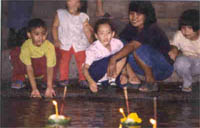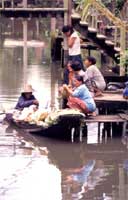|
On the full
moon night of the twelfth lunar month, the tide in the rivers is highest
and the moon at its brightest, creating a romantic setting ideal for
lovers. The Thai people choose this day to hold the 'Loy Kratong' festival,
or the 'festival of light.' Loy Kratong is one of the two most recognized
festivals in the country.
Loy
Kratong is probably the most picturesque and beautiful of all Thai
celebrations. 'Loy' literally means 'to float,' while 'kratong' refers to
the lotus-shaped receptacle which can float on the water. Originally, the
kratong was made of banana leaves or the layers of the trunk of a banana
tree or a spider lily plant. A kratong contains food, betel nuts, flowers,
joss sticks, candle and coins. The making of a kratong is much more
creative these days as many more materials are available.
 The
Loy Kratong ritual is a simple one. One needs only to light the candles
and the joss sticks, make one's wishes and let it float away with the
current of a river or a canal. The
Loy Kratong ritual is a simple one. One needs only to light the candles
and the joss sticks, make one's wishes and let it float away with the
current of a river or a canal.
On that
day, thousands of people will gather beside the canals and rivers. With
kratong in hands, they light the candle, put some coins in the kratong and
silently make a wish, and carefully place their kratongs in the water and
release them to the current.
They watch
intently as the float drifts silently downstream, hoping that the candle
will not go out. Its flame is said to signify longevity, fulfillment of
wishes and release from sins. Altogether it is considered a romantic night
for couples or lovers. Couples who make a wish together on Loy Kratong are
thought to stay together in the future.
Origins
 Different
legends surround the origins of Loy Kratong. The most popular version is
it was an expression of gratitude to the goddess of water 'Phra Mae Kongka'
for having extensively used, and sometimes polluted, the water from the
rivers and canals. It is also in part a thanksgiving for her bounty in
providing water for the livelihood of the people. Different
legends surround the origins of Loy Kratong. The most popular version is
it was an expression of gratitude to the goddess of water 'Phra Mae Kongka'
for having extensively used, and sometimes polluted, the water from the
rivers and canals. It is also in part a thanksgiving for her bounty in
providing water for the livelihood of the people.
Some
believe the festival originates from Buddhism. They say the offering of
flowers, candles and joss-sticks is a tribute of respect to the footprint
of the Lord Buddha on the sandy beach of the Narmaha River in India, as
well as to the great Serpent and dwellers of the underwater world, after
the Lord Buddha's visit to their watery realm. It is possible that this is
derived from a Hindu festival that pays tribute to the god Vishnu, who
meditates at the center of the ocean.
Others
believe that the floral kratong is offered to the pagoda containing the
Lord Buddha's topknot, which was cut off at his self-ordination and is now
in heaven. Another explanation is that it is a way to pay respect to one's
ancestors.
 Whatever
the true origin, the practice of Loy Kratong first began in the ancient
kingdom of Sukhothai in the 13th century. A young queen named Nang
Noppamas was believed to be the one who made a small boat laden with
candles and incense and floated it down the river. The name Nang Noppamas
has been associated with Loy Kratong ever since. Whatever
the true origin, the practice of Loy Kratong first began in the ancient
kingdom of Sukhothai in the 13th century. A young queen named Nang
Noppamas was believed to be the one who made a small boat laden with
candles and incense and floated it down the river. The name Nang Noppamas
has been associated with Loy Kratong ever since.
Today, Loy
Kratong offers a unique occasion to celebrate. It's a good time for people
to make wishes and look to the future as they float their floral offerings
along the waterways.
Where
to celebrate
Although celebrated nationwide, Loy Kratong is particularly delightful in
the provinces of Sukhothai, Chiang Mai, Ayutthaya and Bangkok.
As the
place of origin of the festival, Sukhothai rightly remains the focal point
of the celebrations. The festival comes with a spectacular light-and-sound
show held in the ancient and traditional setting of the Sukhothai
historical park.
 Chiang
Mai is another prime site to celebrate Loy Kratong. The festival is known
in northern dialect as 'Yi Peng.' The largest kratongs are decorated
floats, paraded through the town on trucks. The colorfully lit floats form
a long glittering parade as they make their way to the river. Chiang
Mai is another prime site to celebrate Loy Kratong. The festival is known
in northern dialect as 'Yi Peng.' The largest kratongs are decorated
floats, paraded through the town on trucks. The colorfully lit floats form
a long glittering parade as they make their way to the river.
Meanwhile,
up above thousands of 'khom loy' (floating lanterns) drift into the night
sky. These large balloon-like lanterns are released at temples and
sometimes from private homes in the hope that misfortune flies away with
them.
The Chao
Phraya River is one of the main waterways to celebrate the Loy Kratong
festival. In Bangkok, riverside hotels organize special celebrations for
their guests. In some hotels, swimming pools are turned into a temporary
river for the Loy Kratong celebration.
Environmental Issues
Although Loy Kratong is an old Thai tradition, celebrated continuously
since ancient times, the use of modern foam materials to make the kratong
has taken its toll on the environment.
Today,
instead of synthetic foams, natural materials such as the original banana
leaves or even bread have been used to make the floats. In addition,
kratong are increasingly being released in small canals or swimming pools
to prevent pollution in the rivers. In this way, the old tradition can
still be preserved while our rivers and waterways remain in pristine
condition for future generations.
|